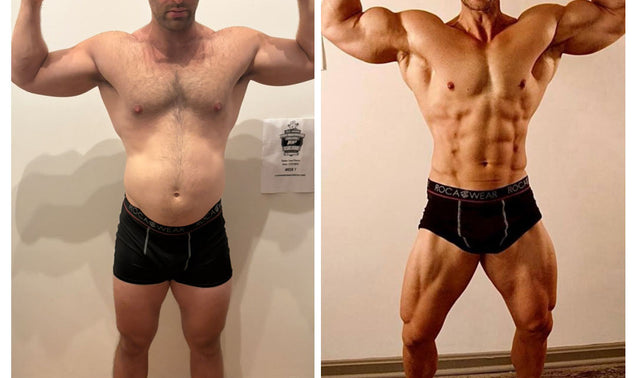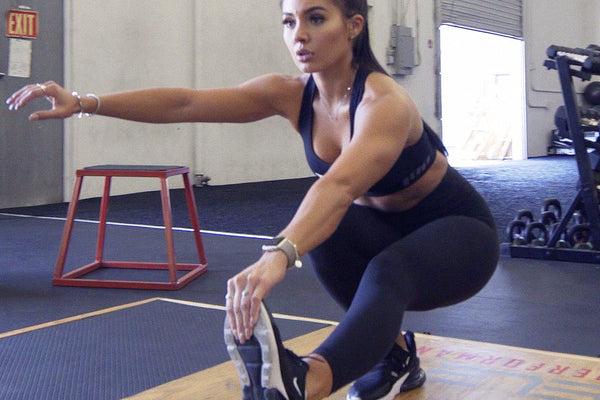The pistol squat is an advanced unilateral bodyweight exercise for the lower body used to build single leg strength, improve balance, and enhance mobility.
As an advanced exercise, less experienced lifters struggle to perform the movement (for a variety of reasons).
In this article, we’ll discuss how to master the pistol squats as well as the long list of benefits to be gained from adding it to your training program.
How to Perform Pistol Squats
Step 1
Begin by standing on one leg, with the toes pointed forward or slightly turned out. Your non-working leg is held straight in front of you, with the foot flexed.
Note: As with any type of squat, it is important that your knee tracks in line with your toes. This reduces shearing forces on the knee and helps protect against pain and unnecessary wear and tear on your joints.
Step 2
“Root” your working foot into the ground so that all of your weight is evenly distributed across the foot. Tighten your core and extend your arms at shoulder height in front of your body. These will act as a sort of counterbalance and help you to maintain an upright posture when performing the pistol squat.
Step 3
Begin lowering by breaking at the hip and knee, slowly controlling the descent.
As you lower into the bottom position, your non-working leg will continue to travel in front of your body. At the bottom position, the non-working leg will be extended straight out in front of you hovering parallel to the ground. The glute of your working leg will be resting on your calf.
Now comes the hard part...standing back up!
Step 4
Powerfully contract your leg muscles to begin your ascent from the bottom position. Instead of imagining yourself standing up, try envisioning that you are pushing the ground away. Make sure you are evenly pressing through your foot during the exercise -- no rising up on the toes or rocking back on the heel.
Step 5
Return to a full, stable, standing position and repeat for desired number of reps.
Catch your breath and then repeat on the other leg.
Top 5 Benefits of Pistol Squats
Unilateral Strength
As a single-leg exercise, the pistol squat helps build unilateral strength.
We’ve touched on the benefits of unilateral training before, but essentially, we all have one side of our body that is stronger than the other. This is commonly referred to as our dominant side.
What this means is that during bilateral movements (back squats, leg press, overhead press, etc.), one side of our body is working harder than the other. The degree to which the dominant side lifts more than the non-dominant side hinges on how great the deficit is between your dominant and non-dominant side.
If left unchecked, this discrepancy continues to grow, which can lead to eventual pain and injury.
Incorporating unilateral exercises, such as the pistol squat, help address and prevent these imbalances from happening (or worsening) since you have to perform the movement with each side of your body.
Joint Mobility
Properly performing a pistol squat requires an individual to have sufficient ankle, knee, and hip mobility.
The amount of joint flexion that takes place at the ankle, knee, and hip is similar to that of an ass-to-grass squat.
Improving your ability to generate force (and control it) throughout a joint’s entire range of motion is crucial to long term joint health and function.
Greater Balance and Stability
The pistol squat is a unilateral exercise that requires a greater degree of balance, stability, and coordination than a bilateral lower body exercise, such as the bodyweight squat.
Developing greater balance and stability not only helps you become stronger in potentially compromising positions, but also helps reduce the risk of injury.
Sports-Specific Skill
Unilateral movements are highly athletic and provide a great deal of functional strength, which is useful for athletes, both amateur and professional.
Just about every athletic movement is performed on one leg. By improving your single-leg strength and stability, you are improving your overall athleticism, which benefits your performance in other areas of fitness, such as field sports, CrossFit, strongman, etc.
Can Be Performed Anywhere
Bodyweight training has become insanely popular in recent years, in large part due to increasing demands placed on our time. What this means is that we’re busier than ever and have less and less time to spend in the gym.
Bodyweight training essentially requires only your body, gravity, and Mother Earth.
Note: a place to do pull ups is also helpful, but that’s a topic for another article.
Bodyweight exercises are great for building muscle and strength as well as improving your coordination and functional fitness. However, one limitation of most bodyweight exercises for the lower body is that they’re not very challenging.
For example, most people can rep out dozens and dozens of reps of bodyweight squats and lunges before fatiguing, which limits the muscle-building potential of these top quality movements.
The pistol squat, however, places significant levels of tension on your legs and forces one of your legs to handle lifting your entire bodyweight. This is a considerable challenge even for very advanced lifters out there.
If you’re strapped for time and/or don’t want to go to the gym, but still want to get in a killer lower body workout, then you want to make sure pistol squats are included in your routine.
Pistol Squat Pointers
Performing unassisted, full range of motion pistol squats is a daunting challenge ever for experienced lifters who have gained considerable amounts of size and strength.
Here are a few pointers you can put to use while you work your way to the perfect pistol squat.
Use an Assist
Few people have the strength, balance, or coordination to achieve an unassisted pistol squat on their first attempt.
To help your body learn the proper movement pattern and balance as well as help it come out of the hole (the bottom position), an “assist” can help.
For assistance, you can use a wall, a chair, an ottoman, a table or any other sturdy object.
Assisted pistol squats also allow you to measure where your “sticking point” in the exercise is -- coming up from the bottom, the mid-range, etc.
Knowing at which point of the exercise you’re weakest will help you know where you need to work on building strength.
Perform Partial Reps
Partial reps are just what they sound like -- you’re performing an exercise through a partial range of motion.
While we usually recommend performing exercises through a full range of motion, with bodyweight strength exercises like the pistol squat, performing unassisted partial reps is a method to match the difficulty of an exercise to your strength and skill level.
With other exercises, such as the bench press or bilateral squat, you can decrease the weight on the bar to accommodate your strength levels. Since pistol squats are performed with bodyweight, there’s no plates for you to remove to lighten the load.
Therefore, to make the exercise manageable, we play with partial ranges of motion.
To perform partial reps, you’ll need some kind of stable, elevated surface, such as a plyo box, bench, or chair.
If you’re relatively new to the exercise, you should start with a surface that is about knee height and gradually use shorter and shorter implements until you can achieve a full range of motion.
An easy way to measure progress on your pistol squats this is to set a sets and reps goal.
For instance, once you can perform 5 reps on each leg for 5 sets, swap out the taller box or bench for a smaller one.
Keep progressing in this manner until you no longer need an elevated surface and are able to perform full range of motion reps.
Incorporate Isometrics
Isometrics are static positions of an exercise in which the muscle is under tension. Performing isometrics in the positions where you are weakest will help build strength and break through those pesky “sticking points.”
Isometrics can be uncomfortable depending on how long you hold the position and which part of the range of motion you perform the isometric. But, “becoming comfortable with being uncomfortable” will pay tremendous dividends towards helping you build the strength, balance, coordination, and confidence to own this exercise.
Performing these isometrics will also help you get accustomed to holding your non-working leg in the air while performing a full range of motion squat with the other leg.
Stand on an Elevated Surface
One of the most difficult aspects of the pistol squat is holding the non-working leg straight in the air.
If you have this problem, try performing the exercise while standing on an elevated surface. This will allow you to hold your leg at a lower height relative to your body, thereby making the exercise a bit easier.






